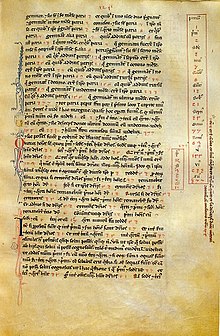Fibonaccifølgja

Fibonaccifølgja er ei følgje av tal der kvart tal unntatt dei to første er summen av dei to føregåande.[1][2] I sin vidaste definisjon kan dei to første tala vere kva som helst, men mest vanleg er å starte på anten 1 og 1 eller 0 og 1:
eller
- .
Historie[endre | endre wikiteksten]

Fibonaccifølgja har namn etter Leonardo Fibonacci sitt forsøk på å beskrive populasjonsvekst hjå ei tenkt gruppe kaninar. Ho blei likevel omtalt mykje tidlegare. Innan gammal indisk matematikk blei ho brukt til å studera prosodi i sanskrit.[3][4] Innan verselæra på sanskrit ønska ein å finna alle mønster av lange (L) stavingar som er 2 einingar lange, og korte (K) stavingar som er 1 eining lang. Tel ein dei ulike mønstera av L og K med ei viss lengd får ein fibonaccifølgja: Talet på mønster som er m korte statvingar lang er fibonaccitalet Fm + 1.[5]
Å finne fibonaccifølgja[endre | endre wikiteksten]
Følgjande program i programmeringsspråket C genererer følgja av fibonaccital som ikkje overstig den maksimale verdien av den største heiltalsdatatypen i standardbiblioteket til C99. Dei to første tala er frivillige argument på kommandolinja.
#include <stdio.h>
#include <stdint.h>
int main(int argc, char *argv[]){
uintmax_t i=1, j=1;
if(argc == 3){
i = strtoll(argv[1], NULL, 0);
j = strtoll(argv[2], NULL, 0);
}
printf("%llu", i);
do{
printf("\n%llu", j);
i = i + j;
if(i < j) break;
printf("\n%llu", i);
j = j + i;
}while(j > i);
putchar('\n');
return 0;
}
Med to eitt-tal som start og 64 bit øvre talgrense, kjem desse 93 tala ut. Dette tek omkring 2 - 10 millisekund på ein moderne PC.
1 1 2 3 5 8 13 21 34 55 89 144 233 377 610 987 1597 2584 4181 6765 10946 17711 28657 46368 75025 121393 196418 317811 514229 832040 1346269 2178309 3524578 5702887 9227465 14930352 24157817 39088169 63245986 102334155 165580141 267914296 433494437 701408733 1134903170 1836311903 2971215073 4807526976 7778742049 12586269025 20365011074 32951280099 53316291173 86267571272 139583862445 225851433717 365435296162 591286729879 956722026041 1548008755920 2504730781961 4052739537881 6557470319842 10610209857723 17167680177565 27777890035288 44945570212853 72723460248141 117669030460994 190392490709135 308061521170129 498454011879264 806515533049393 1304969544928657 2111485077978050 3416454622906707 5527939700884757 8944394323791464 14472334024676221 23416728348467685 37889062373143906 61305790721611591 99194853094755497 160500643816367088 259695496911122585 420196140727489673 679891637638612258 1100087778366101931 1779979416004714189 2880067194370816120 4660046610375530309 7540113804746346429 12200160415121876738
Kjelder[endre | endre wikiteksten]
- ↑ Beck & Geoghegan 2010.
- ↑ Bóna 2011, s. 180.
- ↑ Singh, Parmanand (1985), «The So-called Fibonacci numbers in ancient and medieval India», Historia Mathematica 12 (3): 229–44, doi:10.1016/0315-0860(85)90021-7
- ↑ Knuth, Donald (1968), The Art of Computer Programming 1, Addison Wesley, ISBN 81-7758-754-4, «Before Fibonacci wrote his work, the sequence Fn had already been discussed by Indian scholars, who had long been interested in rhythmic patterns... both Gopala (before 1135 AD) and Hemachandra (c. 1150) mentioned the numbers 1,2,3,5,8,13,21 explicitly [see P. Singh Historia Math 12 (1985) 229–44]" p. 100 (3d ed)...»
- ↑ Knuth, Donald (2006), The Art of Computer Programming, 4. Generating All Trees – History of Combinatorial Generation, Addison–Wesley, s. 50, ISBN 978-0-321-33570-8, «it was natural to consider the set of all sequences of [L] and [S] that have exactly m beats. ...there are exactly Fm+1 of them. For example the 21 sequences when m = 7 are: [gives list]. In this way Indian prosodists were led to discover the Fibonacci sequence, as we have observed in Section 1.2.8 (from v.1)»
- Ball, Keith M (2003), «8: Fibonacci's Rabbits Revisited», Strange Curves, Counting Rabbits, and Other Mathematical Explorations, Princeton, NJ: Princeton University Press, ISBN 0-691-11321-1.
- Beck, Matthias; Geoghegan, Ross (2010), The Art of Proof: Basic Training for Deeper Mathematics, New York: Springer.
- Bóna, Miklós (2011), A Walk Through Combinatorics (3rd utg.), New Jersey: World Scientific.
- Lemmermeyer, Franz (2000), Reciprocity Laws, New York: Springer, ISBN 3-540-66957-4.
- Lucas, Édouard (1891), Théorie des nombres (på fransk) 1, Gauthier-Villars
- Pisano, Leonardo (2002), Fibonacci's Liber Abaci: A Translation into Modern English of the Book of Calculation, Sources and Studies in the History of Mathematics and Physical Sciences, Sigler, Laurence E, trans, Springer, ISBN 0-387-95419-8


